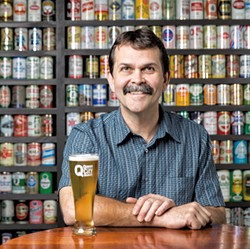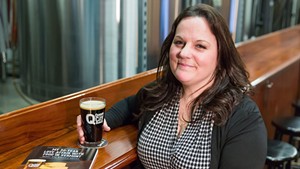
- Oliver Parini
- Paul Hale
It's said that you shouldn't go into business with your friends. But when Paul Hale, Paul Held, Maarten and Sarah van Ryckevorsel, and Phil Kaszuba opened Queen City Brewery in Burlington's South End last summer, that's exactly what they did.
All longtime homebrewers-in-arms, the five shared an affinity for old-school European beers. They opened the brewery on a hunch that locals would embrace the delicate, balanced beers as a break from IPA-mania.
The wager paid off; in little more than a year, Queen City has more than doubled its output, shipping kegs of easy-drinking, old-world brew to more than 150 Vermont bars and restaurants, and 50 more in Boston.
While the copper-toned Landlady Ale is probably its most common off-site draft, Queen City's home bar affords guests a tasting trip through the Euro zone. Many of the styles — steinbier, for instance, made by lowering hot rocks into the kettle rather than heating it from below, or a smoky German rauchbier — are uncommon even in Vermont's fast-expanding beer canon.
Brewery bartenders (often Held himself or his son, Jason, the bar manager) walk first-timers through the draft list with unassuming candor and pub-style friendliness. For serious beer nerds, a visit could mean chatting malt profiles, specific IBUs and the nuances of brewing different styles. But more casual drinkers can come away with just enough basic information to choose a beer they'll enjoy.
Two weeks ago, Seven Days sat down with head brewer Hale, who talked brewing to style, company growth and Queen City's endgame.
SEVEN DAYS: What's the last beer you drank?
PAUL HALE: I had our Gregarious Scotch ale yesterday. It's a strong Scotch ale paying tribute to Greg Noonan — the [late] owner of Vermont Pub & Brewery. He was a pioneer in the Vermont brewing industry, and he was always very helpful to the homebrewing community and other professional brewers. Greg gave me the recipe many years ago — they call it Wee Heavy at the Pub & Brewery. [Mine] is just a slightly scaled-down version.
SD: What else is on draft now?
PH: We have Barge Canal, an oatmeal extra stout —
SD: Dark. Channeling the spirit of the Barge Canal?
PH: We're making a little joke — but only local people get it. Even then, most people don't know the Barge Canal is a Superfund site, so I have to explain it.
SD: So many new beers since the last time I was here!
PH: The guys can't control me.
SD: Has the bar been busy?
PH: Yeah! We get a lot of beer tourists coming through, but we [also] get a lot of regulars from the neighborhood. That's what I envisioned — I wanted tasting-room visitors to feel like they were in the brewery. I also really liked the English pub feel. You go to a pub in England, and people are there with their families. So we've tried to do that a little, too.
SD: Has the addition of Zero Gravity [Craft Brewery] across the street impacted your business?
PH: I don't think we have enough data to know whether it's helped or hurt, but my gut feeling is that it helps. This part of town has become kind of a destination.
SD: All the beer nerds are calling it "Pint Street."
PH: (Whispers) I made that up! I put a hashtag, #PintStreetBTV, when we got our first-class liquor license. Maybe somebody else said it first, but I think I made it up.
SD: Some brewers express trepidation about industry growth. Then, in the next breath, they say the brew community is super-friendly.
PH: Certainly. It's a small place. You have to be nice to everybody. But we help each other. At the American Craft Beer Festival in Boston, I had trouble with my equipment and didn't have the right tool to fix it. Brian Eckert from Four Quarters lent me a tool, and then, half an hour later, the guys from Fiddlehead came over and they'd run out of CO2. I had an extra tank. We needed some yeast nutrient the other day, so my brewer, Lillian, went across the street to [Zero Gravity] and got some. It's like borrowing a cup of sugar from your neighbor.
SD: Given the local affinity for IPAs, I was a bit surprised at people's interest in these European styles.
PH: There's a reason these styles have been made for so long — they're really, really good. One of the things I like about these beers is that they go really well with food, and we're trying to do more [pairing dinners] with restaurants. We provide [the chefs] with four or five kinds of beer, and they drink them and get inspired to make a dish to go with each one.
SD: It's nice that people have caught on to the idea that food and beer can go well together.
PH: Oh, yeah. There's just as much complexity in beer as in wine — you can ponder over a nice glass of beer the same way you can a wine.
SD: Any pairings you're especially fond of?
PH: I naturally gravitate toward the European pairings, but the other night I was at La Boca's, our local pizza restaurant, and they had our Munich dunkel on draft. It paired beautifully with a sandwich with fresh mozzarella and pesto. I wouldn't have thought to pair those, but it was perfect.
SD: Wow!
PH: When you're eating a dish that has these subtle flavors, you don't want a beer that's going to overwhelm or scrub your palate. So most of our beers don't do that. They're kind of gentle and they balance themselves.
SD: What do you think of this wild growth in the beer industry?
PH: This has been my hobby since the 1980s. So, personally, I'm not surprised that people are discovering how great craft beer is. On a national level, I guess we're taking market share away from the big breweries, but peoples' tastes change, and craft beers are more flavorful. Although I have great respect for breweries that can make a light American lager.
SD: They're not easy to make.
PH: No, and any kind of fermentation flaw is not hidden. In fact, I have a recipe [for a beer] called Bushwick pilsner that we haven't made here yet. Bushwick is in Brooklyn, and there used to be four big breweries there. They served Rheingold at Shea Stadium back in the 1970s. I brewed a pilot batch and gave it to an older guy from Long Island, and he said, "Oh, God, that reminds me of going to see the Mets."
SD: Nailed it!
PH: That's what I'm trying to do with all these beers — to have a story and have the beer be accurate to what that style is. We're kind of nerdy about that, because we're beer judges at competitions.
SD: You were a scientist before this. Were you ever interested in making crazy stuff like chocolate-raspberry-sundae stout, etc.?
PH: I only do subtle changes [to a style]. There's the scientific part of it. When you're doing experiments in the laboratory, you need to keep track of things in a very careful way. So if an experiment works, you can reproduce it. If it doesn't work, you have some idea about what you need to change next time. So I guess that led me a little away from the crazy, complicated beers.
SD: After sharing these beers with friends and family for years, how does it feel to push them out to a wider audience?
PH: It's wonderful. That's really the best part of this, just sharing beer with people. Yesterday there were two guys in here who had never heard of steinbier, so I got to tell the story of how we made it for years in my backyard and show them how we lower the rocks into the kettle. They are homebrewers, so I told them what kind of rock and what kind of wood we use. Who knows? Maybe they'll be making it. So that's very rewarding!
SD: How much beer are you making these days?
PH: We're on pace to brew about 1,500 barrels per year. We started at around half — or maybe a third — of that. I laid out a five-year plan, and I think we're pretty close to where I said we'd be in the second year.
SD: As an outsider, you see a brewery grow as much as you have in a year, and you think, There's no way anyone could have planned for that.
PH: A lot of new breweries start too small. You end up doing almost the same amount of work for a half or a third of the product, and you can't make enough revenue to grow quickly on that. A brewpub is a different game — more like a restaurant. But when I wrote the business plan, I realized that this is kind of the minimum size for a production brewery.
SD: That's a big gamble!
PH: It's all a gamble. Brian over at Four Quarters is doing some really interesting things, and he's very small, but he makes a different kind of product. We've already grown a little bit, and we're talking about buying more fermenters. This brewhouse makes 15 barrels at a time, so we have to brew twice in one day to fill the fermenter. The next step will be getting tanks that we'll have to brew three times to fill. Eventually, you get to the point where you say, "That's enough of that; I'm going to get a 30-barrel brewhouse and go from there." At some point, it changes from being a comfortable craft brewery to a factory, and I don't anticipate us reaching that level for many years, if ever. That's not what our goal was. This is my last career — I don't intend to grow some giant business and then sell out. This is what I want to do.











Comments
Showing 1-1 of 1
Comments are closed.
From 2014-2020, Seven Days allowed readers to comment on all stories posted on our website. While we've appreciated the suggestions and insights, right now Seven Days is prioritizing our core mission — producing high-quality, responsible local journalism — over moderating online debates between readers.
To criticize, correct or praise our reporting, please send us a letter to the editor or send us a tip. We’ll check it out and report the results.
Online comments may return when we have better tech tools for managing them. Thanks for reading.